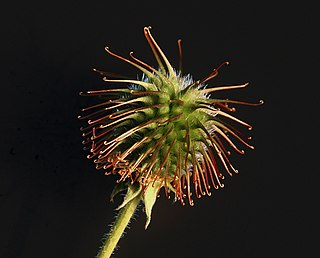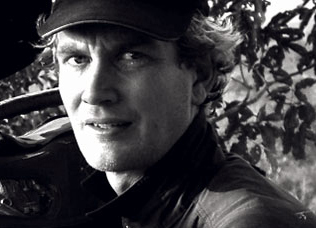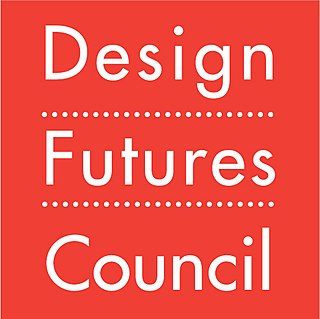
Biomimetics or biomimicry is the emulation of the models, systems, and elements of nature for the purpose of solving complex human problems. The terms "biomimetics" and "biomimicry" are derived from Ancient Greek: βίος (bios), life, and μίμησις (mīmēsis), imitation, from μιμεῖσθαι (mīmeisthai), to imitate, from μῖμος (mimos), actor. A closely related field is bionics.

Conservation in Australia is an issue of state and federal policy. Australia is one of the most biologically diverse countries in the world, with a large portion of species endemic to Australia. Preserving this wealth of biodiversity is important for future generations. 25% of Australia is managed for conservation.

The Land Institute is an American nonprofit research, education, and policy organization dedicated to sustainable agriculture, based in Salina, Kansas. Their goal is to develop an agricultural system based on perennial crops that "has the ecological stability of the prairie and a grain yield comparable to that from annual crops".

Bionics or biologically inspired engineering is the application of biological methods and systems found in nature to the study and design engineering systems and modern technology.
The following outline is provided as an overview of and topical guide to environmental studies:
Bionic architecture is a contemporary movement that studies the physiological, behavioural, and structural adaptions of biological organisms as a source of inspiration for designing and constructing expressive buildings. These structures are designed to be self-sufficient, being able to structurally modify themselves in response to the fluctuating internal and external forces such as changes in weather and temperature.

Christian Baumeister is a German cinematographer and award-winning director focusing on nature and wildlife productions.

The Design Futures Council is an interdisciplinary network of design, product, and construction leaders exploring global trends, challenges, and opportunities to advance innovation and shape the future of the industry and environment. Members include architecture and design firms, building product manufacturers, service providers, and forward-thinking AEC firms of all sizes that take an active interest in their future.
The Earth Awards is an aspirational platform for consumer-driven ideas that challenge designers and innovators to build a new economy. It is an annual competition since 2007, aiming to "transform visionary ideas into market-ready solutions by offering finalists the unique opportunities to pitch their project to world business leaders". The Awards are open to students, graduates and industry professionals - the public is invited to submit innovations to be judged.
The Biomimicry Institute is a 501(c)(3) not-for-profit organization founded in 2006 and based in Missoula, Montana in the United States. Its goal is to help innovators learn from nature in order to design sustainable products, processes, and policies in response to real-world problems. The Biomimicry Institute has become a key communicator in the field of biomimetics, connecting thousands of practitioners and organizations across the world. Its Global Network currently supports 38 regional networks across 26 countries as of 2022. The Biomimicry Institute was founded by Bryony Schwan, Dayna Baumeister and Janine Benyus and originated following the publishing of Biomimicry: Innovation Inspired by Nature by Janine Benyus; a natural sciences writer, innovation consultant and author.
IDEAS For Us is a United Nations–accredited non-governmental organization which works to advance sustainability through local action projects in countries and on campuses around the world. IDEAS For Us focuses on reaching communities furthest from sustainable development and advancing the global goals for sustainable development by helping to develop, fund, and scale local action projects from within communities which have the potential to grow into ongoing programs. IDEAS For Us has three major programs: Fleet Farming, the Hive, and the Solutions Fund.
This is a bibliography of sustainability publications.
Biomimetic architecture is a branch of the new science of biomimicry defined and popularized by Janine Benyus in her 1997 book. Biomimicry refers to innovations inspired by nature as one which studies nature and then imitates or takes inspiration from its designs and processes to solve human problems. The book suggests looking at nature as a Model, Measure, and Mentor", suggesting that the main aim of biomimicry is sustainability.

Love Thy Nature is a 2014 documentary film directed by Sylvie Rokab and narrated by Liam Neeson. The film underwent development in the mid-2000s, with production lasting nearly a decade. Produced and distributed by In The Light Productions, the first version of the film premiered on 18 October 2014 at the Hollywood Film Festival, with a film festival run throughout 2014 and 2015 and a theatrical run with the final version of the film in 2016. It has had over 300 theatrical and community screenings in 140 cities in 16 countries, earned 27 awards, and was covered in 28 publications.
Ecopreneurship is a term coined to represent the process of principles of entrepreneurship being applied to create businesses that solve environmental problems or operate sustainably. The term began to be widely used in the 1990s, and it is otherwise referred to as "environmental entrepreneurship." In the book Merging Economic and Environmental Concerns Through Ecopreneurship, written by Gwyn Schuyler in 1998, ecopreneurs are defined as follows:
"Ecopreneurs are entrepreneurs whose business efforts are not only driven by profit, but also by a concern for the environment. Ecopreneurship, also known as environmental entrepreneurship and eco-capitalism, is becoming more widespread as a new market-based approach to identifying opportunities for improving environmental quality and capitalizing upon them in the private sector for profit. "
Michael Pawlyn is a British architect noted for his work in the field biomimetic architecture and innovation, as well as jointly initiating the 'Architects Declare' movement in the UK. He was part of the principal team of architects that conceived and designed The Eden Project and is a regular keynote speaker at events on innovation and environmental sustainability. His best selling RIBA book Biomimicry in Architecture was published in 2011 and a revised second edition, with a foreword by Ellen MacArthur, was published in 2016. He was one of the three founders of The Sahara Forest Project - a way of supplying fresh water, food and renewable energy in arid conditions - and remains actively involved as a Founding Partner and Design Manager.

Exploration Architecture was established in 2007 by architect Michael Pawlyn.
Bioinspiration is the development of novel materials, devices, and structures inspired by solutions found in biological evolution and refinement which has occurred over millions of years. The goal is to improve modeling and simulation of the biological system to attain a better understanding of nature's critical structural features, such as a wing, for use in future bioinspired designs. Bioinspiration differs from biomimicry in that the latter aims to precisely replicate the designs of biological materials. Bioinspired research is a return to the classical origins of science: it is a field based on observing the remarkable functions that characterize living organisms and trying to abstract and imitate those functions.
Hao Yan is a Chinese-American chemist, a (bio)molecular designer, programmer and engineer.
Javier G. Fernandez is a Spanish physicist and bioengineer. He is associate professor at the Singapore University of Technology and Design. He is known for his work in biomimetic materials and sustainable biomanufacturing, particularly for pioneering chitin's use for general and sustainable manufacturing.







